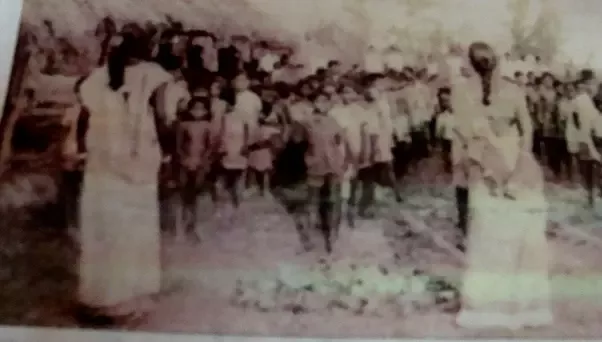Remembering the massacre of the Dalit Hindus by the Communist Regime on its 42nd anniversary!!


Monday marked the 42nd anniversary of one of the worst massacres in independent India that claimed the lives of over a thousand people, many of them women, children and the elderly and most importantly they were all Dalit Hindus. But since the dispensation under whose regime this happened was a Left party government, the massacre finds no mention in the mainstream media. It was a cold-blooded, planned and horrendous massacre that few even in Bengal know about or care to remember.
The partition of India post independence led to huge influx of refugees from both countries. This burden was primarily faced with Punjab in the west and Bengal in the east. In Bengal, there were more people coming into India than leaving. This led to a huge migration imbalance, a burden that West Bengal found difficult to handle. A rough estimate of gigantic influx of refugees came from what was then East Pakistan to West Bengal from 1947 to 1971 is 19 million. That is around the combined populations of Portugal and Sweden.
The Marichjhapi massacre was one of the worst human rights violations in post-independent India In 1977, with the Left Front government in power. These refugees were mostly camped at Orrisa. However, the Leftist opposition in Bengal, led by Mr. Jyoti Basu actively protested against this and wanted these refugees to be given land in Bengal, under the pretext that they are Bengalies.
The refugees who had been rehabilitated in Dandakaranya became hopeful that the new popular government who had always espoused the refugee’s cause would now help them come back to West Bengal. The Left Front minister Ram Chatterjee visited the refugee camps at Dandakaranya and was widely reported to have encouraged the refugees to settle in the Sunderbans, a long held Left demand. So, through the months of March and April 1978, families sold their belongings and left Dandakaranya.
But Left Front policies had changed under new conditions of governmentality. It was also acknowledged that the refugees in Dandakaranya, (under the organisation of Udvastu Unnyanshil Samiti) had refused to be a part of United Central Refugee Council, a Communist Party of India (Marxist) refugee organisation, since they felt that the refugee problem was a national problem and their identity must not be part of any political group. The CPI(M) in turn was miffed at the thought that their dreams of getting electoral advantages in states like Orissa and Madhya Pradesh with a large refugee electorate had become unviable.
The Left Front in West Bengal that had come to power with the refugee vote now urged the deserters to go back to Dandakaranya, refusing to entertain their demand of settling in West Bengal. Many were forcibly sent back but around 10,000 Namasudra refugee families under the leadership of Satish Mandal, president of the Udbastu Unnayanshil Samiti, set sail to relocate in Marichjhapi. (There seems to be some dispute about the exact number of people who managed to settle in Marichjhapi but it can be any where between 4,000 to 10,000 families.) Although it was not an island that was strictly under the mangroves, the government was in no mood to relent. It declared Marichjhapi as a reserve forest and the refugees as violating the forest Acts by destroying “the existing and potential forest wealth and also creating ecological imbalance”.
On January 26, 1979, India’s Republic Day, then Left Front chief minister Jyoti Basu announced an economic blockade of Marichjhapi. Thirty police launches surrounded the island; the refugees were tear-gassed, their huts, fisheries and tube-wells destroyed. Those who tried to cross the river in makeshift boats were shot at. The refugees, armed with carpentry tools and makeshift bows and arrows, were no match for the armed government forces. A conservative estimate gave the dead as several hundreds of men, women and children who died either through starvation or were shot at and their bodies thrown into the Raimangal river. Marichjhapi became out of bounds to visiting journalists, opposition politicians and even a Parliamentary Committee, who came to investigate police atrocities, faced harassment at the hands of the Forest Department officials.
Thus refugees in huge numbers started relocating in Bengal. They were given land in the un-habited islands of Sundarbans. Meanwhile, West Bengal underwent a governmet change, now the Left were on drivers’ seat. While all this was happening, some 40,000-45,000 refugees settled themselves in the island of Marichjhapi. Now this island is protected by law under ‘Wildlife protection act’, or something like that. So the government had to react. The government issued prohibatory orders to little effect. The police soon started economic blocade. As Marichjhapi is an island, its food and water depended entirely on external sources. This led to wide-spread unrest (read violent) because of the severe food/water shortage. People were forced to eat grass!
The islanders attacked the police. This happened on Jan 31, 1979. The police fired back, leading to mass killing of islanders. There are unconfirmed reports that police later dumped the bodies in water for crocodiles to wipe off. Houses were torched, boats sunk, medicines destroyed. Again, this part is sketchy because media was barred from entering the premises. Again, when you close down media, things do get nasty.
But the most important question is this: why did the Left invite all these people over, just to kill them? The Bengal Left leadership, mostly high caste, took up tigers as an excuse to commit genocide on Dalits.
Hardly anyone in India knows about it! There’s a book by Amitava Ghosh called ‘The Hungry Tide‘, to get a detailed record of what happened there. There is a comprehensive explanation of the entire episode both from the economic and the political point of view.
DISCLAIMER: The author is solely responsible for the views expressed in this article. The author carries the responsibility for citing and/or licensing of images utilized within the text.
